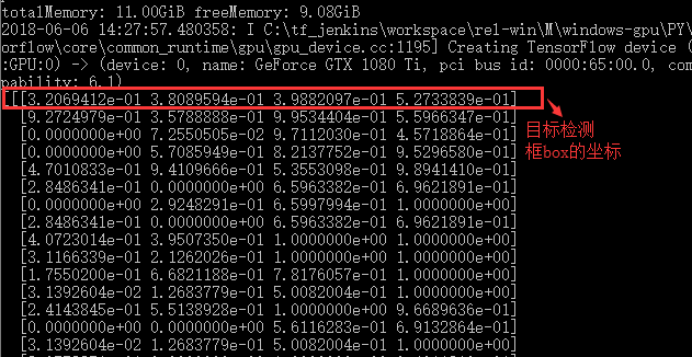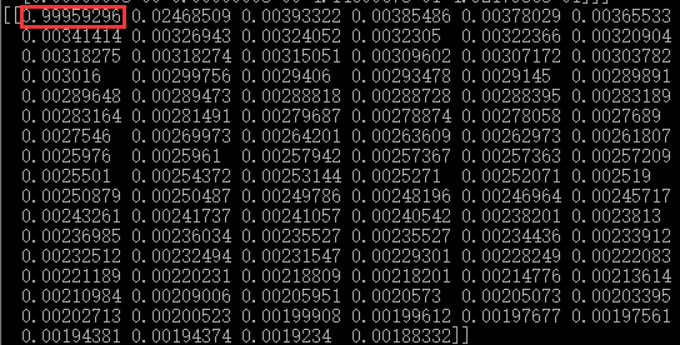【TensorFlow】获取object detection API训练模型的输出坐标
如下图,谷歌开源的object detection API提供了五种网络结构的fine-tuning训练权重,方便我们针对目标检测的需求进行模型训练,本文详细介绍下导出训练模型后,如何获得目标检测框的坐标。如果对使用object detection API训练模型的过程不了解,可以参考博文:https://www.cnblogs.com/White-xzx/p/9503203.html

新建一个测试文件object_detection_test.py,该脚本读取我们已经训练好的模型文件和测试图片,进行测试,代码如下,
1 import numpy as np 2 import os 3 import six.moves.urllib as urllib 4 import sys 5 import tarfile 6 import tensorflow as tf 7 import zipfile 8 9 from collections import defaultdict 10 from io import StringIO 11 from matplotlib import pyplot as plt 12 from PIL import Image 13 14 ## This is needed to display the images. 15 #%matplotlib inline 16 17 # This is needed since the notebook is stored in the object_detection folder. 18 sys.path.append("..") 19 20 from utils import label_map_util 21 22 from utils import visualization_utils as vis_util 23 # What model to download. 24 #MODEL_NAME = 'ssd_mobilenet_v1_coco_2017_11_17' 25 #MODEL_FILE = MODEL_NAME + '.tar.gz' 26 #DOWNLOAD_BASE = #'http://download.tensorflow.org/models/object_detection/' 27 MODEL_NAME = 'data' # 训练过程中保存模型文件的文件夹路径 28 29 # Path to frozen detection graph. This is the actual model that is used for the object detection. 30 PATH_TO_CKPT = MODEL_NAME + '/frozen_inference_graph.pb' # 训练完成导出的pb模型文件 31 32 # List of the strings that is used to add correct label for each box. 33 PATH_TO_LABELS = 'E:/TensorFlow/Box-object-detection/data/label_map.pbtxt' # label_map.pbtxt文件 34 35 NUM_CLASSES = 2 # 类别总数 36 37 #Load a (frozen) Tensorflow model into memory. 加载模型 38 detection_graph = tf.Graph() 39 with detection_graph.as_default(): 40 od_graph_def = tf.GraphDef() 41 with tf.gfile.GFile(PATH_TO_CKPT, 'rb') as fid: 42 serialized_graph = fid.read() 43 od_graph_def.ParseFromString(serialized_graph) 44 tf.import_graph_def(od_graph_def, name='') 45 #Loading label map 加载label_map 46 label_map = label_map_util.load_labelmap(PATH_TO_LABELS) 47 categories = label_map_util.convert_label_map_to_categories(label_map, max_num_classes=NUM_CLASSES, use_display_name=True) 48 category_index = label_map_util.create_category_index(categories) 49 #Helper code 50 def load_image_into_numpy_array(image): 51 (im_width, im_height) = image.size 52 return np.array(image.getdata()).reshape( 53 (im_height, im_width, 3)).astype(np.uint8) 54 55 # For the sake of simplicity we will use only 2 images: 56 # image1.jpg 57 # image2.jpg 58 # If you want to test the code with your images, just add path to the images to the TEST_IMAGE_PATHS. 59 PATH_TO_TEST_IMAGES_DIR = 'test_images' # 测试图片的路径 60 #TEST_IMAGE_PATHS = [ os.path.join(PATH_TO_TEST_IMAGES_DIR, 'image{}.jpg'.format(i)) for i in range(1, 3) ] 61 TEST_IMAGE = sys.argv[1] 62 print("the test image is:", TEST_IMAGE) 63 64 # Size, in inches, of the output images. 65 IMAGE_SIZE = (12, 8) 66 with detection_graph.as_default(): 67 with tf.Session(graph=detection_graph) as sess: 68 #for image_path in TEST_IMAGE_PATHS: 69 image = Image.open(TEST_IMAGE) # 打开图片 70 # the array based representation of the image will be used later in order to prepare the 71 # result image with boxes and labels on it. 72 image_np = load_image_into_numpy_array(image) 73 # Expand dimensions since the model expects images to have shape: [1, None, None, 3] 74 image_np_expanded = np.expand_dims(image_np, axis=0) 75 image_tensor = detection_graph.get_tensor_by_name('image_tensor:0') # 获取图片张量 76 # Each box represents a part of the image where a particular object was detected. 77 boxes = detection_graph.get_tensor_by_name('detection_boxes:0') # 获取检测框张量 78 # Each score represent how level of confidence for each of the objects. 79 # Score is shown on the result image, together with the class label. 80 scores = detection_graph.get_tensor_by_name('detection_scores:0') # 获取每个检测框的分数,即概率 81 classes = detection_graph.get_tensor_by_name('detection_classes:0') # 获取类别名称id,与label_map中的ID对应 82 num_detections = detection_graph.get_tensor_by_name('num_detections:0') # 获取检测总数 83 # Actual detection. 84 (boxes, scores, classes, num_detections) = sess.run( 85 [boxes, scores, classes, num_detections], 86 feed_dict={image_tensor: image_np_expanded}) 87 # Visualization of the results of a detection.结果可视化 88 vis_util.visualize_boxes_and_labels_on_image_array( 89 image_np, 90 np.squeeze(boxes), 91 np.squeeze(classes).astype(np.int32), 92 np.squeeze(scores), 93 category_index, 94 use_normalized_coordinates=True, 95 line_thickness=8) 96 97 print(boxes) # 打印检测框坐标 98 print(scores) #打印每个检测框的概率 99 print(classes) # 打印检测框对应的类别 100 print(category_index) # 打印类别的索引,其是一个嵌套的字典 101 102 final_score = np.squeeze(scores) 103 count = 0 104 for i in range(100): 105 if scores is None or final_score[i] > 0.5: # 显示大于50%概率的检测框 106 count = count + 1 107 print("the count of objects is: ", count ) 108 109 plt.figure(figsize=IMAGE_SIZE) 110 plt.imshow(image_np) 111 plt.show()
打开cmd,输入如下命令,
python object_detection_test.py ./test_images/2.png
运行结果如下,

目标检测框box的坐标,此处的坐标是坐标除以相应图片的长宽所得到的小数,排列顺序为[ymin , xmin , ymax , xmax],即box检测框左上角和右下角的坐标,

同时显示的是目标检测框box的概率:

Box的标签索引和每个索引所代表的标签,如第一个box的索引为1,1的标签名为“box”,即检测框里的是“箱子”

检测图:

因为源码中将坐标与图片的长宽相除,所以显示的是小数,为了得到准确的坐标,只要乘上相应的长宽数值就可以得到坐标了,上图的检测图坐标由计算可得
[ymin , xmin , ymax , xmax] = [ 614.4 , 410.4 , 764.16 , 569.16 ],即在y轴的坐标和使用pyplot显示的坐标相近(图中红线标出)。
接下来,我们只要将上面的测试代码稍加修改即可得到我们想要的坐标,比如获得每个检测物体的中心坐标,代码如下:
1 import numpy as np 2 import os 3 import six.moves.urllib as urllib 4 import sys 5 import tarfile 6 import tensorflow as tf 7 import zipfile 8 import time 9 10 from collections import defaultdict 11 from io import StringIO 12 from matplotlib import pyplot as plt 13 #plt.switch_backend('Agg') 14 from PIL import Image 15 16 ## This is needed to display the images. 17 #%matplotlib inline 18 19 # This is needed since the notebook is stored in the object_detection folder. 20 sys.path.append("..") 21 22 from utils import label_map_util 23 24 from utils import visualization_utils as vis_util 25 # What model to download. 26 #MODEL_NAME = 'ssd_mobilenet_v1_coco_2017_11_17' 27 #MODEL_FILE = MODEL_NAME + '.tar.gz' 28 #DOWNLOAD_BASE = #'http://download.tensorflow.org/models/object_detection/' 29 MODEL_NAME = 'E:/Project/object-detection-Game-2018-5-31/data-20180607' # model.ckpt路径,包括frozen_inference_graph.pb文件 30 31 # Path to frozen detection graph. This is the actual model that is used for the object detection. 32 PATH_TO_CKPT = MODEL_NAME + '/frozen_inference_graph.pb' 33 34 # List of the strings that is used to add correct label for each box. 35 PATH_TO_LABELS = MODEL_NAME+'/label_map.pbtxt' 36 #E:/Project/object-detection-Game-2018-5-31 37 38 NUM_CLASSES = 6 39 start = time.time() 40 #Load a (frozen) Tensorflow model into memory. 41 detection_graph = tf.Graph() 42 with detection_graph.as_default(): 43 od_graph_def = tf.GraphDef() 44 #loading ckpt file to graph 45 with tf.gfile.GFile(PATH_TO_CKPT, 'rb') as fid: 46 serialized_graph = fid.read() 47 od_graph_def.ParseFromString(serialized_graph) 48 tf.import_graph_def(od_graph_def, name='') 49 #Loading label map 50 label_map = label_map_util.load_labelmap(PATH_TO_LABELS) 51 categories = label_map_util.convert_label_map_to_categories(label_map, max_num_classes=NUM_CLASSES, use_display_name=True) 52 category_index = label_map_util.create_category_index(categories) 53 #Helper code 54 def load_image_into_numpy_array(image): 55 (im_width, im_height) = image.size 56 return np.array(image.getdata()).reshape( 57 (im_height, im_width, 3)).astype(np.uint8) 58 59 60 # If you want to test the code with your images, just add path to the images to the TEST_IMAGE_PATHS. 61 #PATH_TO_TEST_IMAGES_DIR = 'test_images' 62 #TEST_IMAGE_PATHS = [ os.path.join(PATH_TO_TEST_IMAGES_DIR, 'image{}.jpg'.format(i)) for i in range(1, 3) ] 63 TEST_IMAGE = sys.argv[1] 64 print("the test image is:", TEST_IMAGE) 65 66 # Size, in inches, of the output images. 67 IMAGE_SIZE = (12, 8) 68 with detection_graph.as_default(): 69 with tf.Session(graph=detection_graph) as sess: 70 # Definite input and output Tensors for detection_graph 71 image_tensor = detection_graph.get_tensor_by_name('image_tensor:0') 72 # Each box represents a part of the image where a particular object was detected. 73 detection_boxes = detection_graph.get_tensor_by_name('detection_boxes:0') 74 # Each score represent how level of confidence for each of the objects. 75 # Score is shown on the result image, together with the class label. 76 detection_scores = detection_graph.get_tensor_by_name('detection_scores:0') 77 detection_classes = detection_graph.get_tensor_by_name('detection_classes:0') 78 num_detections = detection_graph.get_tensor_by_name('num_detections:0') 79 #for image_path in TEST_IMAGE_PATHS: 80 image = Image.open(TEST_IMAGE) 81 # the array based representation of the image will be used later in order to prepare the 82 # result image with boxes and labels on it. 83 image_np = load_image_into_numpy_array(image) 84 # Expand dimensions since the model expects images to have shape: [1, None, None, 3] 85 image_np_expanded = np.expand_dims(image_np, axis=0) 86 image_tensor = detection_graph.get_tensor_by_name('image_tensor:0') 87 # Each box represents a part of the image where a particular object was detected. 88 boxes = detection_graph.get_tensor_by_name('detection_boxes:0') 89 # Each score represent how level of confidence for each of the objects. 90 # Score is shown on the result image, together with the class label. 91 scores = detection_graph.get_tensor_by_name('detection_scores:0') 92 classes = detection_graph.get_tensor_by_name('detection_classes:0') 93 num_detections = detection_graph.get_tensor_by_name('num_detections:0') 94 # Actual detection. 95 (boxes, scores, classes, num_detections) = sess.run( 96 [boxes, scores, classes, num_detections], 97 feed_dict={image_tensor: image_np_expanded}) 98 # Visualization of the results of a detection. 99 vis_util.visualize_boxes_and_labels_on_image_array( 100 image_np, 101 np.squeeze(boxes), 102 np.squeeze(classes).astype(np.int32), 103 np.squeeze(scores), 104 category_index, 105 use_normalized_coordinates=True, 106 line_thickness=8) 107 108 #print(boxes) 109 # for i in range(len(scores[0])): 110 # if scores[0][i]>0.5: 111 # print(scores[0][i]) 112 #print(scores) 113 #print(classes) 114 #print(category_index) 115 final_score = np.squeeze(scores) 116 count = 0 117 for i in range(100): 118 if scores is None or final_score[i] > 0.5: 119 count = count + 1 120 print() 121 print("the count of objects is: ", count ) 122 (im_width, im_height) = image.size 123 for i in range(count): 124 #print(boxes[0][i]) 125 y_min = boxes[0][i][0]*im_height 126 x_min = boxes[0][i][1]*im_width 127 y_max = boxes[0][i][2]*im_height 128 x_max = boxes[0][i][3]*im_width 129 print("object{0}: {1}".format(i,category_index[classes[0][i]]['name']), 130 ',Center_X:',int((x_min+x_max)/2),',Center_Y:',int((y_min+y_max)/2)) 131 #print(x_min,y_min,x_max,y_max) 132 end = time.time() 133 seconds = end - start 134 print("Time taken : {0} seconds".format(seconds)) 135 136 # plt.figure(figsize=IMAGE_SIZE) 137 # plt.imshow(image_np) 138 # plt.show()
运行结果如下,






 浙公网安备 33010602011771号
浙公网安备 33010602011771号